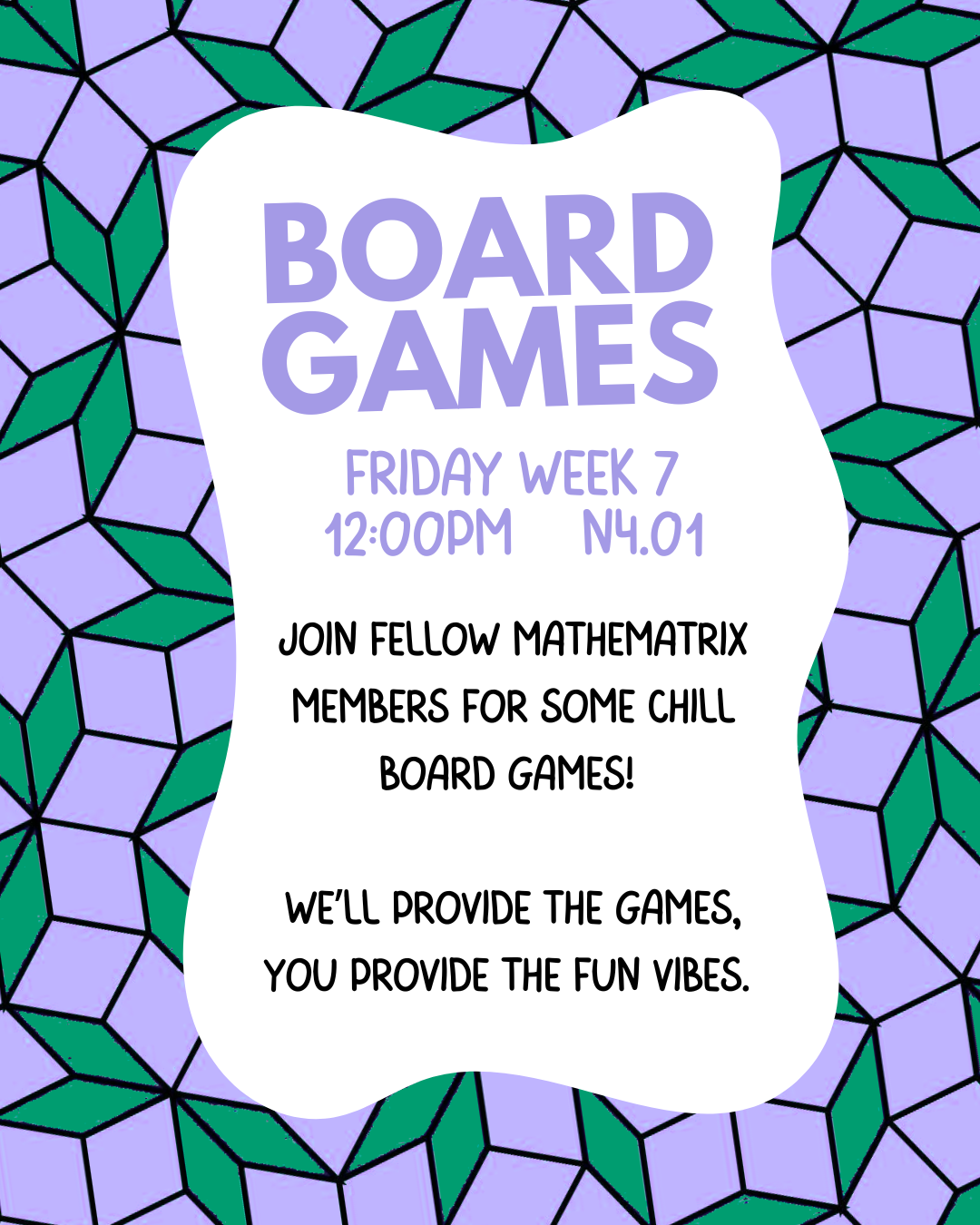Mathematrix: Board Games!
Abstract
Join us on Friday Week 7 for some chill board games! Meet in N4.01 at 12pm for a Taylors sandwich lunch and positive end-of-term vibes.

Join us on Friday Week 7 for some chill board games! Meet in N4.01 at 12pm for a Taylors sandwich lunch and positive end-of-term vibes.

Mathematicians often like to think of maths as objective. Science communicator Hana Ayoob joins us to discuss how the fact that humans do maths means that the ways maths is developed, used, and communicated are not neutral.
Join us for an initial welcome pizza lunch to start the academic year to learn about what's happening in Mathematrix in 2025/26! Meet other students who are from underrepresented groups in mathematics and allies :)
Please RSVP here to confirm your spot: https://form.jotform.com/252814345456864
Due to connections to flat space holography, Carrollian geometry, physics and fluid dynamics have received an explosion of interest over the last two decades. In the Carrollian limit of vanishing speed of light c, relativistic fluids reduce to a set of PDEs called the Carrollian fluid equations. Although in general these equations are not well understood, and their PDE theory does not appear to have been studied, in dimensions 1+1 it turns out that there is a duality with the Galilean compressible Euler equations in 1+1 dimensions inherited from the isomorphism of the Carrollian (c to 0) and Galilean (c to infinity) contractions of the Poincar\'e algebra. Under this duality time and space are interchanged, leading to different dynamics in evolution. I will discuss recent work with N. Athanasiou (Thessaloniki), M. Petropoulos (Paris) and S. Schulz (Pisa) in which we establish the first rigorous PDE results for these equations by introducing a notion of Carrollian isentropy and studying the equations using Lax’s method and compensated compactness. In particular, I will explain that there is global existence in rough norms but finite-time blow-up in smoother norms.
Galilean and Carrollian algebras are dual contractions of the Poincaré algebra. They act on two-dimensional Newton--Cartan and Carrollian manifolds and are isomorphic. A consequence of this property is a duality correspondence between one-dimensional Galilean and Carrollian fluids. I will describe the algebras and the dynamics of these systems as they emerge from the relevant limits of Lorentzian hydrodynamics, and explore the advertised duality relationship. This interchanges longitudinal and transverse directions with respect to the flow velocity, and permutes equilibrium and out-of-equilibrium observables, unveiling specific features of Carrollian physics. I will also discuss the hydrodynamic-frame invariance in Lorentzian systems and its fate in the Galilean and Carrollian avatars.
Come along for free Pizza and to hear about the Mathematrix events this term.
It is also possible to join online via Microsoft Teams.
Hydrodynamic excitations corresponding to sound and shear modes in fluids are characterized by gapless dispersion relations. In the hydrodynamic gradient expansion, their frequencies are represented by power series in spatial momenta. In this talk we will discuss the convergence properties of the hydrodynamic series by studying the associated spectral curve in the space of complexified frequency and complexified spatial momentum. For the N=4 supersymmetric Yang-Mills plasma at infinite 't Hooft coupling, we will use the holographic methods to demonstrate that the derivative expansions have finite non-zero radii of convergence. Obstruction to the convergence of hydrodynamic series arises from level-crossings in the quasinormal spectrum at complex momenta. We will discuss how finiteness of 't Hooft coupling affects the radius of convergence. We will show that the purely perturbative calculation in terms of inverse 't Hooft coupling gives the increasing radius of convergence when the coupling is decreasing. Applying the non-perturbative resummation techniques will make radius of convergence piecewise continuous function that decreases after the initial increase. Finally, we will provide arguments in favour of the non-perturbative approach and show that the presence of nonperturbative modes in the quasinormal spectrum can be indirectly inferred from the analysis of perturbative critical points.